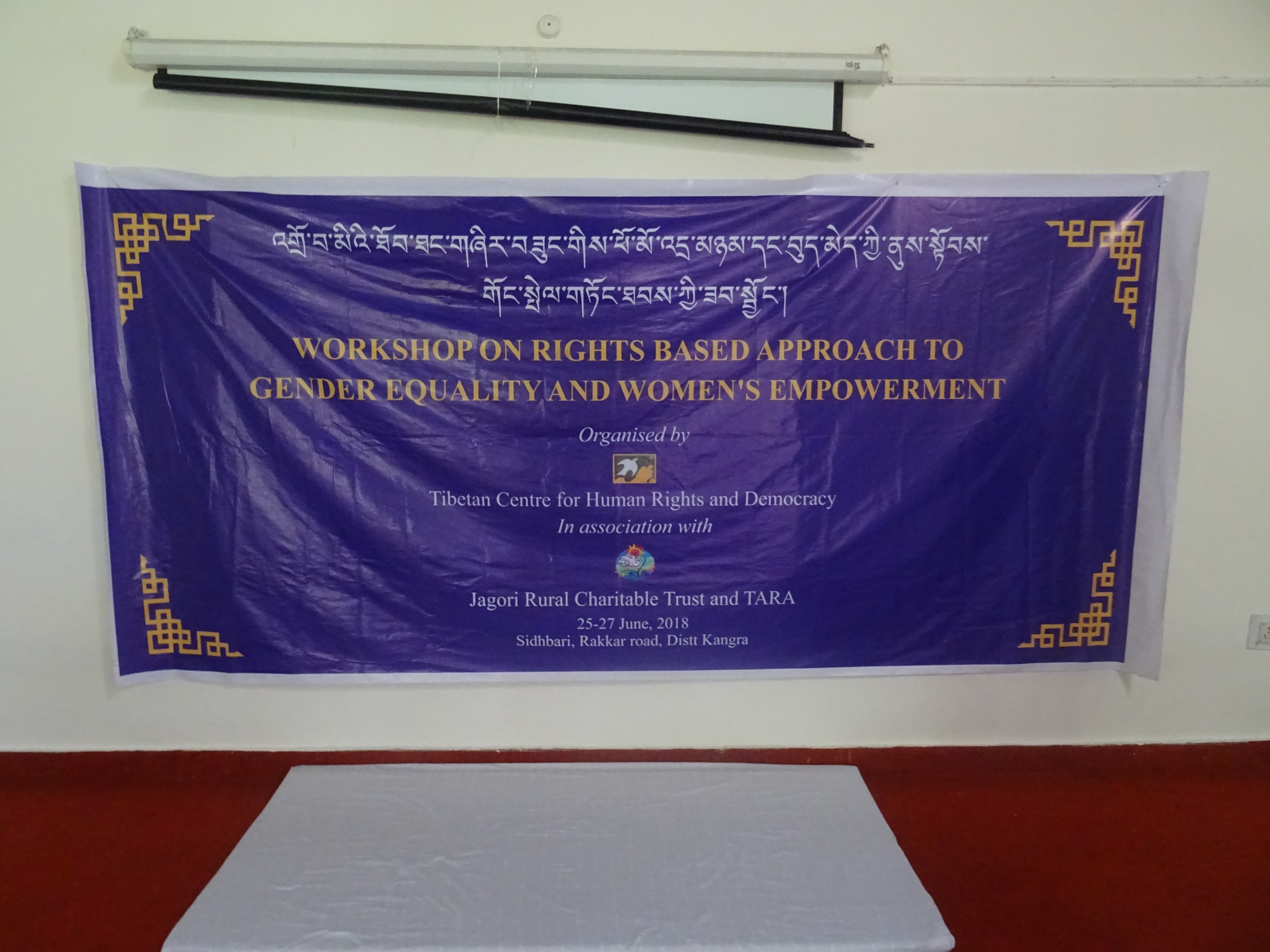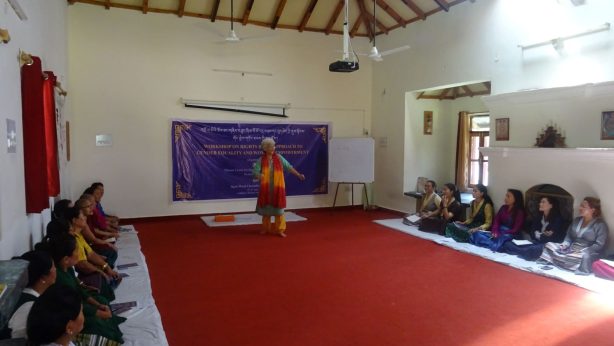TCHRD submits civil society recommendations on gender equality and women’s empowerment to Central Tibetan Administration
 On 6 August, the Tibetan Centre for Human Rights and Democracy (TCHRD) submitted a set of recommendations on gender equality and women’s empowerment to the Central Tibetan Administration’s Women’s Empowerment Desk and the Kashag Secretariat/Cabinet Secretariat as well as to the secretariat of Tibetan Parliament-in-exile.
On 6 August, the Tibetan Centre for Human Rights and Democracy (TCHRD) submitted a set of recommendations on gender equality and women’s empowerment to the Central Tibetan Administration’s Women’s Empowerment Desk and the Kashag Secretariat/Cabinet Secretariat as well as to the secretariat of Tibetan Parliament-in-exile.
The recommendations were compiled from a civil society consultation conducted by TCHRD. The consultation was part of a three-day workshop on the rights-based approach to gender equality and women’s empowerment organised by TCHRD from 25 to 27 June 2018. A total of 30 female participants reviewed the revised Tibetan Women’s Empowerment Policy (‘policy’) and made recommendations on how the policy can better serve Tibetan women. Among the participants were students, teachers, farmers, nuns, entrepreneurs, tour guides, human rights researchers, members of regional chapters of Tibetan Women’s Association, and a trainer on gender sensitisation and gender equality.
TCHRD commend the efforts of the Central Tibetan Administration (CTA) in issuing the revised policy on Tibetan women’s empowerment and in publicly stating its commitment to achieve a more just and egalitarian society. The overall goal of the policy is to make Tibetan women “equal partners in all aspects of the Tibetan society”. Similar to any society around the world, gender equality does not exist in Tibetan society; therefore women’s empowerment is imperative.
Key highlights from the civil society consultation include calls for placing the overall policy in a human rights framework emphasising the importance of a rights-based approach to achieving gender equality and women’s empowerment; holding periodic reviews and consultations with civil society groups; building strong and mutually-reinforcing partnerships among all stakeholders involved in women’s empowerment; developing a comprehensive plan of action on the prevention and management of sexual and gender based violence; and setting up institutional mechanisms including gender equality machinery to monitor and ensure the implementation of the revised policy.
Presented below are the detailed recommendations that participants propose to be considered during any future revisions to the policy:
- Adopt the Human Rights Based Approach to Gender Equality
Gender equality is a basic human right and is crucial for achieving a just and egalitarian society. The principle of equal rights of women and men is at the heart of the Charter of the UN, the Universal Declaration of Human Rights and all other major international human rights instruments. It is most comprehensively elaborated in the Convention on the Elimination of All Forms of Discrimination against Women (CEDAW), the international women’s rights treaty that provides the framework for advocating for women’s human rights. The global UN conferences such as the Vienna Declaration and Programme of Action of the World Conference on Human Rights (1993) have not only reaffirmed women’s rights as an intrinsic dimension of human rights but also identified gender-based violence as a subject of international human rights law. Likewise, the Beijing Platform for Action of the Fourth World Conference on Women (1995) firmly anchors the achievement of gender equality within a human rights framework and made famous the slogan: ‘Women’s Rights Are Human Rights!’ Additionally, the International Conference on Population and Development (1994, Cairo) and the World Summit for Social Development (1995, Copenhagen) acknowledged gender equality as a human right.
Despite the overriding importance of human rights in realising gender equality, the policy contains a single reference to human rights: “Create awareness on human rights violation pertaining to Tibetan women in Tibet in the international community and global forums”. This reference is inadequate given the strong connection between women’s rights and human rights. The key areas for women’s empowerment identified in the policy are directly related to human rights. The human rights to education, health, economic freedom, political representation, equal opportunities, and freedom from all kinds of violence are enshrined in major international human rights treaties. Therefore future revisions to the policy should consider prioritising the promotion and protection of human rights of women, men, girls and boys as one of the goals.
- Conduct Periodic Assessment and Community-based Consultations
A periodic assessment of the policy highlighting achievements made and areas that need further improvement would benefit all stakeholders. The first policy was drafted in October 2008 and not revised until February 2017, almost a nine-year gap. It is proposed that the CTA consider either an annual or biennial assessment of the policy and subsequently issue a public report. Other relevant stakeholders including civil society groups such women’s NGOs should be allowed to submit their perspectives or recommendations on the periodic assessment report. It is recommended that all future revisions to the policy be informed by consultative meetings with parliament members, senior CTA officials, media, NGOs, grassroots leaders, religious leaders, youth groups and other relevant stakeholders. By involving a wide spectrum of the Tibetan community, the CTA can understand the perspectives of the Tibetan people on gender equality and women’s empowerment, the key areas of concern and how these concerns can be addressed.
- Build Strong and Mutually Reinforcing Partnerships Among All Stakeholders
Realising the goal of gender equality would require the CTA to engage in dialogue and cooperation with relevant stakeholders. It is recommended that when implementing, monitoring or evaluating the policy, the CTA forge strong and mutually reinforcing partnerships with relevant stakeholders in the community so that there is a collective and concerted push towards reducing gender inequality. Such partnerships would particularly focus on facilitating equal access to resources and opportunities including capacity building or providing funding for smaller, grassroots-based groups and individuals working for gender equality and women’s empowerment.
- Develop Comprehensive Plan of Action on Prevention and Management of SGBV cases
A comprehensive and systematic plan of action to prevent and manage sexual and gender based violence is crucial to its eventual elimination. Such a plan of action should take into consideration all aspects of SGBV including carrying out research and analysis on gender biases and gender-related violence in the community, conducting intensive sensitisation programme on the causes and effects of SGBV, introducing specific regulations prohibiting all forms of violence against women, sensitising school teachers on gender issues and promoting an enabling environment in schools for students to report SGBV. A good place to start is to provide a definite timeframe for the establishment of a redressal mechanism for those who have experienced SGBV, as stated in the revised policy.
- Create Gender Equality Machinery to Monitor Implementation of the Revised Policy
It is imperative that gender equality machinery with a clear mandate, accountability and authority is created at the earliest time possible to ensure the effective and efficient implementation of the policy. The proposed gender equality machinery would support the CTA in mainstreaming a gender equality perspective in all its policies and programmes. In the meantime, it is recommended that the CTA appoint professional human resource or staff to the Women’s Empowerment Desk. The Women’s Empowerment Desk should develop a strong network by holding periodic consultations and forging partnerships with other stakeholders. A strong network on gender equality and women’s empowerment would encourage sharing of skills and information, and further collaboration on projects and goals.
- Refrain from using Benevolently Sexist Language
Throughout the ‘introduction’ of the policy, women are portrayed in traditional caring roles, which is not beneficial to the overall objective of the policy, which is equality and dismantling harmful gender norms. For instance, paragraph six encourages the “recruitment of women as kindergarten teachers”, which reinforce dangerous stereotypes or perpetuates ‘benevolent sexism’.
- Acknowledge Lack of Gender Equality in Tibetan Community
The aim of the policy is to highlight issues that impede women’s empowerment, however, six out of the seven introductory paragraphs focus on achievements already made, with only one paragraph addressing the need for further improvement. While it is important to highlight the progress that has been made, the introduction should examine why there is a need for this policy and an overview of key issues.
- Policy Language Requires Greater Clarity and Specificity
The sentence in section 4.1 of the policy ends with ‘etc.’ More specification is needed to emphasise exactly what encouragement, facilitation and support women entrepreneurs would be provided other than “training” and “access to financial services”. This clarity is important for future monitoring and evaluation purposes and also because this is an important policy document.

